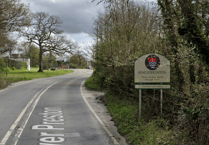Phew, what a scorcher this week! writes Sarah Buck.
Three Newton Abbot Ramblers’ walks were cancelled because of the hot weather, but a moorland and a coastal walk did go ahead.
Peter Thomson led a stunning coastal and rural walk in East Devon on Wednesday. The forecast heat had reduced numbers, but the five walkers were so fortunate to see amazing coastal views all the way to Portland, the World Heritage Site of the Jurassic coast and much of architectural and historical interest.
The walk started gently in Sidmouth by walking along the River Sid, at just over six miles in length it is reputed to be the shortest of England’s rivers. Passing the recently refurbished Old Toll House, which is thought to have been built for the Honiton and Sidmouth Turnpike Trust in 1817, at about the same time as the nearby Waterloo Bridge, the Byes walk was followed in the parkland maintained by the Sid Valley Association.
This association was founded in 1846, as the first Civic Society in Britain, to protect the landscape amenities of the Sid Valley and it is still very vibrant.
Crossing the river over a new bridge at Fortescue the climb started up Soldier’s Hill, perhaps so named after the Salcombe Regis war memorial at the top of the hill.
The Grade II listed war memorial is made of Cornish granite and was originally erected to commemorate the seven local men who gave their lives in World War I. The names of another nine, who gave their lives in World War II, were added in the 1940s.
The hidden gem of Salcombe Regis Church has a history which can be traced back to Norman times. As well as the Norman font and late Medieval/Tudor wall paintings, it also has an unusual glass altar triptych; a stunning modern creation of engraved glass designed by Sir Laurence Whistler and engraved by his son, Simon.
A fairly level stretch through fields led the walkers to the Donkey Sanctuary with its fields filled with what appeared to be hundreds of donkeys. The sanctuary was started in 1969 by Dr Elisabeth Svendsen when she bought a donkey named Naughty Face.
It is now a visitor attraction as well rescuing and looking after donkeys and mules.
Perhaps foolishly the group decided to have lunch on the beach at Weston Mouth.
The lunch stop was good, but the 188 steps to get back to the cliff top was quite an effort! Walking along the top of Higher and Lower Dunscombe Cliffs there were many pits where flints were once quarried.
The coastal stretch was challenging with drops down to two valleys and over the day over 600m of ascent was completed. Water and rest stops in the shade were frequent and very welcome and thankfully the nine mile walk was completed on a level stretch in appreciated shade.
On Thursday Ray led a moorland walk from Harefoot Cross with the heat moderated by a cooling breeze.



-with-lightning).jpeg?width=209&height=140&crop=209:145,smart&quality=75)

Comments
This article has no comments yet. Be the first to leave a comment.